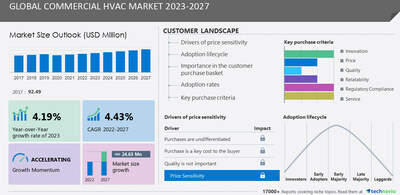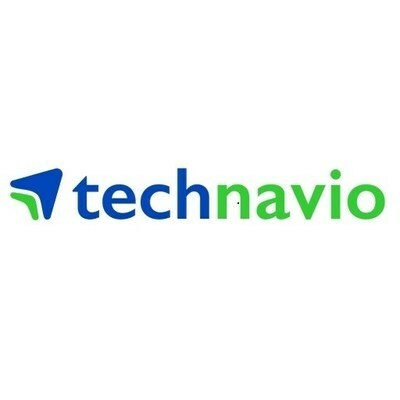Commercial HVAC Market size to grow by USD 24.63 million from 2022 to 2027, Technavio
NEW YORK, March 25, 2024 /PRNewswire/ -- The commercial HVAC market size is set to witness significant growth in the coming years, according to a recent market analysis. The market size is estimated to expand by USD 24.63 million between 2022 and 2027, with a compound annual growth rate (CAGR) of 4.43%.
The report analyses the market size and growth and provides accurate predictions of the market's growth. View a PDF Sample
A myriad of factors is driving this growth, with the rising number of data centers being a prominent driver. With the proliferation of data generation across various industries, the demand for data centers and servers has surged, leading to an increased need for HVAC systems to maintain optimal conditions for critical equipment. This trend is particularly evident in regions such as the US, UK, Germany, China, Canada, and the Netherlands.
Moreover, the surge in internet penetration, IoT-connected devices, and smart technologies has further propelled the demand for data centers, consequently driving the need for efficient HVAC systems.
The report analyses the market size and growth and provides accurate predictions of the market's growth. View a PDF Sample
The market is also witnessing a significant trend towards smart and connected HVAC systems. Advancements in portable devices and monitoring systems have enabled end-users to better manage their HVAC systems, resulting in improved energy efficiency and reduced installation costs. Integration with IoT technologies has further enhanced the capabilities of HVAC systems, offering benefits such as real-time monitoring and predictive maintenance.
However, the market is not without its challenges. High market competition, particularly in regions like APAC, has led to price-based competition and the proliferation of counterfeit products. To combat this, companies are resorting to strategies such as strategic alliances, partnerships, and mergers and acquisitions to enhance their market presence.
The report analyses the market size and growth and provides accurate predictions of the market's growth. View a PDF Sample
In terms of market segmentation, the equipment segment is expected to witness significant growth during the forecast period. This segment includes heating equipment, ventilation equipment, and air conditioning equipment, driven by the rise in construction activities and the increasing adoption of energy-saving systems in commercial spaces.
Geographically, the Asia-Pacific (APAC) region is poised to contribute significantly to the global commercial HVAC market, accounting for 34% of the market growth. This growth is fueled by increased infrastructure spending on commercial projects, particularly in emerging economies such as India, China, Vietnam, and the Philippines.
The report analyses the market size and growth and provides accurate predictions of the market's growth. View a PDF Sample
Commenting on the market outlook, a spokesperson for the market analysis firm stated, "The commercial HVAC market is witnessing steady growth driven by technological advancements, increasing infrastructure spending, and rising awareness about energy efficiency and sustainability. Companies operating in this space need to focus on innovation and strategic partnerships to stay competitive in this rapidly evolving landscape."
The comprehensive market analysis provides insights into key market drivers, trends, challenges, and customer landscapes, enabling companies to refine their marketing strategies and gain a competitive edge.
Analyst Review
The commercial HVAC (Heating, Ventilation, and Air Conditioning) market is witnessing significant advancements driven by the demand for energy-efficient solutions and the increasing need for comfortable indoor environments across various sectors. Key components such as thermostats, dampers, condenser fans, compressors, evaporators, and blowers play pivotal roles in ensuring optimal performance and energy efficiency of HVAC systems.
Thermostats serve as the control hub, allowing users to regulate temperature settings and optimize energy usage based on occupancy patterns and environmental conditions. Dampers enable precise airflow control within ducts, enhancing comfort and energy efficiency by directing air where it's needed most.
Condenser fans and compressors are integral to the cooling process, facilitating heat exchange and refrigerant compression to maintain desired indoor temperatures. Evaporators work in tandem with condenser units to absorb heat from indoor air, while blowers distribute conditioned air throughout the building efficiently.
Energy usage is a critical consideration in commercial HVAC systems, with advancements such as variable-speed drives and smart controls helping to minimize energy consumption without compromising comfort. Coolers are essential for maintaining optimal temperatures in refrigeration applications, ensuring the preservation of perishable goods in commercial settings.
Cooling towers play a crucial role in large-scale HVAC systems by dissipating heat from water-cooled chillers, contributing to energy efficiency and system reliability. Variable Refrigerant Flow (VRF) systems are gaining popularity for their ability to provide precise temperature control and zoning flexibility, making them ideal for commercial applications with diverse heating and cooling needs.
In environments like data centers where precise temperature and humidity control are essential for equipment performance and longevity, sophisticated HVAC solutions are paramount. Advanced cooling technologies, coupled with intelligent controls, help optimize energy usage while ensuring stable operating conditions for sensitive equipment.
Overall, the commercial HVAC market continues to evolve with innovations aimed at enhancing energy efficiency, comfort, and sustainability. From traditional components like thermostats and compressors to cutting-edge technologies like VRF systems and data center cooling solutions, the industry is poised for continued growth as businesses prioritize efficient and reliable HVAC solutions to meet their evolving needs.
The report analyses the market size and growth and provides accurate predictions of the market's growth. View a PDF Sample
Market Overview
The commercial HVAC market continues to evolve, with a range of advanced technologies enhancing efficiency and performance. Thermostats play a pivotal role in regulating temperature, while dampers control airflow for optimal comfort. Condenser fans and compressors work in tandem to manage refrigerant flow, ensuring effective cooling. Evaporators facilitate heat exchange, supported by blowers for air distribution. Energy usage remains a key focus, driving innovations in energy-efficient solutions. Coolers and cooling towers provide additional cooling capacity for large-scale systems. Variable Refrigerant Flow (VRF) systems offer precise temperature control and zoning flexibility, ideal for commercial spaces. Data centers, requiring stringent temperature management, rely on sophisticated HVAC solutions for reliable operation and energy efficiency.
The report analyses the market size and growth and provides accurate predictions of the market's growth. View a PDF Sample
Related Reports:
The HVAC Control Systems Market size is estimated to grow at a CAGR of 7.7% between 2022 and 2027 and the size of the market is forecast to increase by USD 9335.64 million.
The HVAC rental equipment market size is estimated to grow at a CAGR of 5.53% between 2022 and 2027. The market size is forecast to increase by USD 1,799.86 million.
ToC:
1 Executive Summary
2 Landscape
3 Sizing
4 Historic Size
5 Five Forces Analysis
6 Segmentations
7 Customer Landscape
8 Geographic Landscape
9 Drivers, Challenges, and Trends
10 Vendor Landscape
11 Vendor Analysis
12 Appendix
About Technavio
Technavio is a leading global technology research and advisory company. Their research and analysis focus on emerging market trends and provide actionable insights to help businesses identify market opportunities and develop effective strategies to optimize their market positions.
With over 500 specialized analysts, Technavio's report library consists of more than 17,000 reports and counting, covering 800 technologies, spanning 50 countries. Their client base comprises enterprises of all sizes, including over 100 Fortune 500 companies. This growing client base relies on Technavio's comprehensive coverage, extensive research, and actionable market insights to identify opportunities in existing and potential markets and assess their competitive positions within changing market scenarios.
Contacts
Technavio Research
Jesse Maida
Media & Marketing Executive
US: +1 844 364 1100
UK: +44 203 893 3200
Email: [email protected]
Website: www.technavio.com
SOURCE Technavio
News published on and distributed by:





